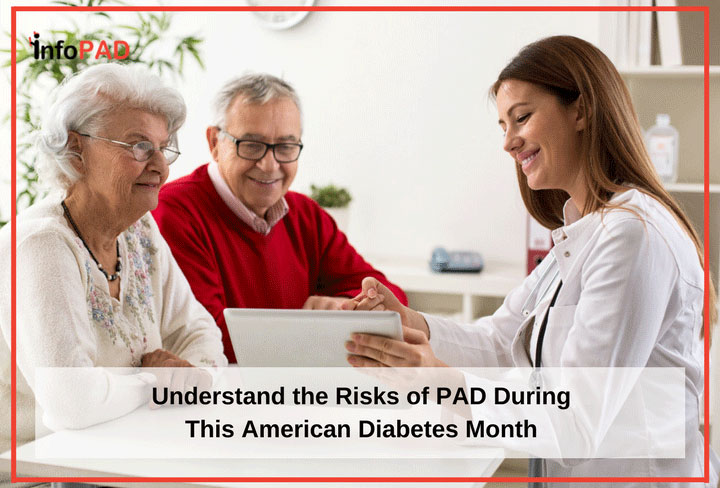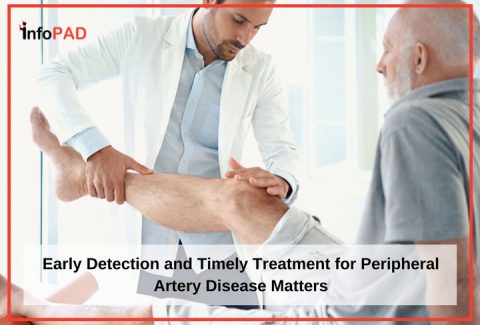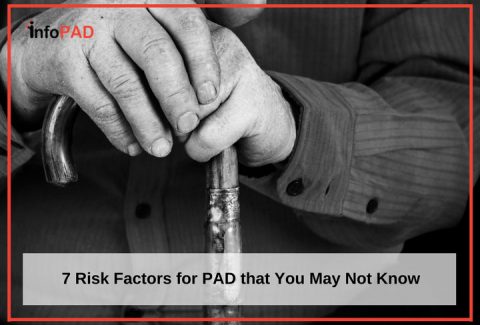
Peripheral arterial disease (PAD) is a common condition, yet many are still unfamiliar with its symptoms and serious risks, including heart attack, stroke, or amputation. People with diabetes are at higher risk for developing this circulatory disease, and in honor of American Diabetes Month this November we are helping spread awareness to how diabetes may lead to PAD and, if diagnosed, steps to take to prevent this disease from progressing.
Presently, 30.3 million Americans are living with diabetes, and another 86 million are at risk for it. Each November, the American Diabetes Association spreads awareness of this disease by educating people on the causes and symptoms for type 1 and 2 diabetes, as well as the complications and comorbidities that arise as a result of diabetes.
You are at risk of developing prediabetes or Type 2 diabetes if you:
- Are overweight
- Are age of 45 years or older
- Have a parent or sibling(s) with type 2 diabetes
- Are physically active fewer than 3 times per week
- Gave birth to a baby that weighed more than 9 pounds
- Have ever had gestational diabetes
Race and ethnicity play a role in the likelihood that someone will develop Type 2 diabetes. African Americans, Hispanics/Latino Americans, American Indians, Pacific Islanders, and some Asian Americans are at higher risk.
What are Type 1, Prediabetes and Type 2 Diabetes?
Type 1 diabetes, which is commonly found in children and young adults, only accounts for approximately 5% of all people with the disease. [I] With Type 1 diabetes, the body is unable to produce insulin and consequently cannot transfer glucose (a simple sugar which is used for energy) from the bloodstream into the cells of the body. People with diabetes can manage their diabetes with Insulin therapy combined with other treatments.
Prediabetes is a condition in which blood glucose levels are higher than normal. More than 1 in 3 Americans have prediabetes, of those, 90% don’t know they have it. People with prediabetes are likely to develop type 2 diabetes within the next decade, and thus, they must take action to lower the risk. Adopting a healthier lifestyle that includes weight management, healthy eating, and an increase in physical activity can delay or prevent prediabetes from progressing to diabetes.[II]
Type 2 diabetes accounts for the other 95% of people living with diabetes. In the past, type 2 diabetes was commonly seen in older adults, but in recent years, children are now being diagnosed with it due to the increase in obesity rates. This form of diabetes causes the body to improperly use the insulin secreted by the pancreas and typically causes the body to overcompensate and produce more insulin than needed. Over time the body can no longer maintain this production and cannot keep blood glucose levels stable, resulting in illness and severe complications. [III] A combination of medication, a healthy diet and exercise can help control Type 2 diabetes. If not controlled properly, diabetes can lead to a series of complications and other illnesses including Peripheral Arterial Disease (PAD).
Diabetes and Peripheral Arterial Disease
Peripheral Artery Disease (PAD) occurs when blood vessels in the limbs become narrowed or blocked by fat deposits; as a result, blood flow to the limbs decreases. If this condition is not treated properly, it can lead to heart attack, stroke, non-healing foot ulcers and, in extreme cases, amputation. People living with diabetes have a much higher risk for PAD. In fact, an estimated 1 out of every 3 people with diabetes over the age of 50 has PAD.4

Other risk factors for PAD include:
- Smoking
- High blood pressure
- Abnormal blood cholesterol levels
- Overweight
- Physical inactivity
- Over age 50
- Family or personal history of heart disease or stroke
Diabetes alone can be challenging to manage, but combined with PAD, a variety of other complications that threaten the body, specifically involving the limbs, may occur. The following key steps may help you lower your risk of peripheral arterial disease:
- Maintain your blood sugar level in the normal range
- Control your blood pressure
- Manage your weight
- Work closely with your health care team to ensure your urine albumin levels are being monitored. (The American Diabetes Association suggests that people with type 2 diabetes should be screened for urine albumin levels at the time of diagnosis and once a year thereafter.) [II]
Even if you follow these guidelines, it is still possible to get PAD. Therefore, it is vital to know the signs so that if you think you may have the condition, you can promptly receive treatment to avoid complications.
The most common PAD symptoms are:
- Painful cramping in your hip, thighs, or calf muscles
- Leg numbness or weakness
- Non healing sores on your feet, legs or toes
- Discoloration of the leg
If you are experiencing one of more of these PAD symptoms or risk factors, you should ask your doctor about peripheral artery disease so they can properly evaluate your symptoms. If you learn that you are living with PAD, there are many treatments available, including non-surgical, minimally invasive options.
What are PAD Treatment Options?
If you have been diagnosed with PAD, the major goals for treatment include: reducing symptoms, improving quality of life and mobility, and preventing heart attack, stroke, and amputation. With the help of your health care provider, you will determine which of the PAD treatment options is suitable for you.
There are three main approaches to treating PAD:
- Making lifestyle changes
- Taking medication
- Having a surgical or interventional procedure performed
If your condition has progressed and cannot be improved by making lifestyle changes or taking medication, there are several minimally invasive, non-surgical options to treat PAD.
Arteriogram
An arteriogram is an imaging test that uses x-rays and a contrast agent (sometimes referred to as “dye”) to see inside arteries.
Angioplasty and Stenting
Angioplasty is used to open narrowed arteries. This technique involves a very small balloon attached to a thin catheter, which is inserted into a blood vessel through a small nick in the skin. The catheter is threaded, under x-ray guidance, to the site of the blockage then the balloon is inflated to open the artery. Sometimes, a small metal scaffold, called a stent, is inserted to keep the blood vessel open and improve blood flow.

Atherectomy
An atherectomy is a minimally-invasive method for treating PAD that removes the plaque within the vessel. The advantages of atherectomy are less vessel trauma, no foreign object left in the body, and future treatment options are open for the patient.
Make sure to be your own advocate for better health! Both diabetes and PAD are serious medical conditions that are often overlooked and can be managed if recognized and treated early. If you think you are at risk, find a center near you seek evaluation by a PAD specialist, and be sure to get screened at the first sign of the above mentioned symptoms.
Sources:
I Centers for Disease Control and Prevention. (2017, October 2). Prediabetes. Retrieved November 7, 2017, from https://www.cdc.gov/diabetes/basics/type1.html
II https://www.cdc.gov/diabetes/basics/prediabetes.html
III http://www.diabetes.org/diabetes-basics/type-1/?loc=util-header_type1
IV American Diabetes Association. (2014, September 24). Peripheral Arterial Disease (PAD). Retrieved November 7, 2017, from http://www.diabetes.org/living-with-diabetes/complications/heart-disease/peripheral-arterial-disease.html?referrer=https://www.google.com/


